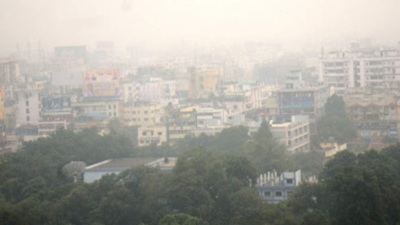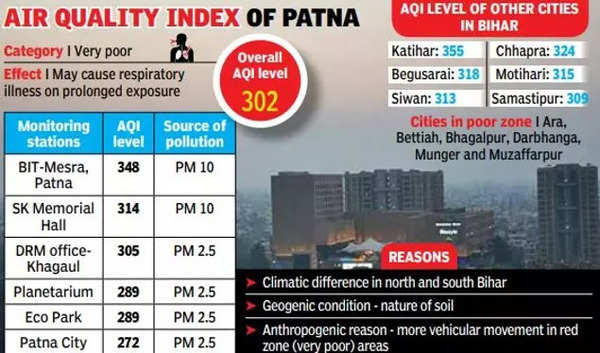- News
- City News
- patna News
- Patna air quality turns toxic, slips to 'very poor' category
Patna air quality turns toxic, slips to 'very poor' category

Apart from Patna, six more cities and towns in Bihar recorded 'very poor air day' on Saturday
PATNA: The air quality in Patna has turned toxic and slipped to the 'very poor' category on Saturday due to accumulation of pollutants near the earth surface owing to weak winds, fall in temperature and other unfavourable weather conditions.

This is the first 'very poor air day' of the season in Patna. Earlier, the city experienced 'very poor air day' on April 27, when the air quality index (AQI) was registered at 227.
The average AQI level of the city was recorded above 300 on Saturday, from 260 (poor zone) the previous day.
Track the pollution level in your city
The air quality early warning system of the ministry of earth sciences has predicted further spike in pollutant levels in the coming two days due to meteorological conditions, including decline in minimum temperature, formation of thermal inversion and moisture incursion.
Apart from Patna, six more cities and towns in Bihar recorded 'very poor air day' on Saturday, with Katihar recording 355 AQI, Chhapra 324, Begusarai 318, Motihari 315, Siwan 313 and Samastipur 309.
Ara & Muz AQI 'poor'
The other towns, including Ara, Bettiah, Bhagalpur, Darbhanga, Munger and Muzaffarpur were also in the 'poor zone'.
According to the Central Pollution Control Board (CPCB) bulletin, Patna's AQI was at 302 in 'very poor' zone. It was based on the readings of six continuous ambient air quality monitoring centres at BIT-Mesra, Patna (346), S K Memorial Hall (314), DRM office, Khagaul (305), planetarium (289), Eco Park (283) and Patna City (272).
The average concentrations of PM 2.5 (particulate matter less than 2.5 micron) stood at 86 micrograms per cubic metre (g/m3) while the PM 10 (particulate matter less than 10 micron) was recorded at 172 g/m3 on Saturday, which is considered unhealthy and can cause issues for people with existing breathing problem such as asthma.
An AQI between zero and 50 is considered 'good', 51 and 100 is 'satisfactory', 101 and 200 'moderate', 201 and 300 'poor', 301 and 400 'very poor' and 401 and 500 'severe'. According to experts, the 'very poor air day' can cause respiratory illnesses on prolonged exposure.
Bihar State Pollution Control Board (BSPCB) chairman Ashok Kumar Ghosh said there were three possibilities and reasons for the rise in AQI level in north Bihar cities and towns - climatic, geogenic and anthropogenic. "The difference in temperature in north and south Bihar is one of the reasons why many cities and towns in north Bihar are experiencing very poor day," he said. "The nature of soil is another reason. In north Bihar, we found soft soil due to flooding every year, which brings sandy soil and silt that hardly settle. Also, due to change in course of the rivers, which exposes new area and settlement where the soil is softer. In south Bihar, most of the towns like Gaya, Sasaram and Nalanda, which are closer to Jharkhand, have rocky areas and they are in the moderate zone, Ghosh told TOI.

This is the first 'very poor air day' of the season in Patna. Earlier, the city experienced 'very poor air day' on April 27, when the air quality index (AQI) was registered at 227.
The average AQI level of the city was recorded above 300 on Saturday, from 260 (poor zone) the previous day.
Track the pollution level in your city
The air quality early warning system of the ministry of earth sciences has predicted further spike in pollutant levels in the coming two days due to meteorological conditions, including decline in minimum temperature, formation of thermal inversion and moisture incursion.
Apart from Patna, six more cities and towns in Bihar recorded 'very poor air day' on Saturday, with Katihar recording 355 AQI, Chhapra 324, Begusarai 318, Motihari 315, Siwan 313 and Samastipur 309.
Ara & Muz AQI 'poor'
The other towns, including Ara, Bettiah, Bhagalpur, Darbhanga, Munger and Muzaffarpur were also in the 'poor zone'.
According to the Central Pollution Control Board (CPCB) bulletin, Patna's AQI was at 302 in 'very poor' zone. It was based on the readings of six continuous ambient air quality monitoring centres at BIT-Mesra, Patna (346), S K Memorial Hall (314), DRM office, Khagaul (305), planetarium (289), Eco Park (283) and Patna City (272).
The average concentrations of PM 2.5 (particulate matter less than 2.5 micron) stood at 86 micrograms per cubic metre (g/m3) while the PM 10 (particulate matter less than 10 micron) was recorded at 172 g/m3 on Saturday, which is considered unhealthy and can cause issues for people with existing breathing problem such as asthma.
An AQI between zero and 50 is considered 'good', 51 and 100 is 'satisfactory', 101 and 200 'moderate', 201 and 300 'poor', 301 and 400 'very poor' and 401 and 500 'severe'. According to experts, the 'very poor air day' can cause respiratory illnesses on prolonged exposure.
Bihar State Pollution Control Board (BSPCB) chairman Ashok Kumar Ghosh said there were three possibilities and reasons for the rise in AQI level in north Bihar cities and towns - climatic, geogenic and anthropogenic. "The difference in temperature in north and south Bihar is one of the reasons why many cities and towns in north Bihar are experiencing very poor day," he said. "The nature of soil is another reason. In north Bihar, we found soft soil due to flooding every year, which brings sandy soil and silt that hardly settle. Also, due to change in course of the rivers, which exposes new area and settlement where the soil is softer. In south Bihar, most of the towns like Gaya, Sasaram and Nalanda, which are closer to Jharkhand, have rocky areas and they are in the moderate zone, Ghosh told TOI.
FOLLOW US ON SOCIAL MEDIA
FacebookTwitterInstagramKOO APPYOUTUBE
Start a Conversation
end of article









